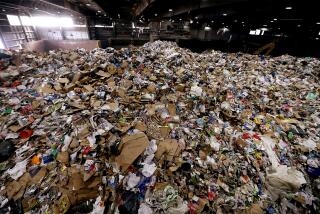HOLIDAYS : Limits of Giving : Experts discourage providing too many toys for kids, but many parents think it’s fine.
- Share via
Melody Meyer vividly remembers a friend’s dismay at the mountains of toys in the Meyers’ Canoga Park home.
“She walked in and goes, ‘I never remembered toys being scattered from one end of your house to the other,’ ” said Meyer, the mother of two daughters, age 5 and 3 1/2. “Of course, that’s coming from a person who doesn’t have any kids.”
Meyer admits that her children have too many toys.
She is not alone.
Experts say kids have far more toys today than ever before, and the situation cuts through all economic classes. Television advertising plays a major role, but the driving force, they say, is parents, grandparents and other family members who are trying hard to please youngsters--and themselves.
“I’m amazed at some of the things that parents tell me they’ve given their children for gifts,” said Dr. Willa Olsen, a Northridge pediatrician. “From birth to 3 years old, it seems like, for the most part, (presents) are given for the parents’ pleasure, not the child’s.”
With Christmas only a few shopping trips away, the situation for most families is going to get worse before it gets better. But there are ways to keep the number of toys under control.
Janet Fish, professor of child development at Cal State Northridge, said children respond best when limits are set and adhered to, whether it’s the amount of television they view, how much candy they eat or how many toys they have.
“You can keep reminding yourself that you have a better sense of what is appropriate than your child does, even if the TV tells them otherwise,” Fish said. “Also remember that when given too many things to attend to, a kid can’t select and concentrate on the use of a given toy. Clutter increases a child’s anxiety and nervousness.”
Fish recommends the following general guidelines when considering toys for children:
Birth to 6 months. Mobiles are popular items, but make sure they are constructed in a way that an infant can enjoy them. “If, for example, the angle of the animals is vertical so that we as adults can see these delicious images and the child can only see the underside, this is not a good toy,” Fish said.
Do not be lulled into buying any toy because of its colorful appearance. Children under 6 months are more enamored by the contrast between black and white.
“As adults, we usually choose pastels and other colors that are pleasing to the eye, but that’s not necessarily to (the children’s) benefit,” she said.
Six months to 3 years. Consider the three S’s: size, sanitation and surfaces. Like it or not, children are going to explore the world with their mouths. Toys should be big enough so that they cannot be swallowed, but can be easily washed.
Once children begin walking, they enjoy pull toys. Toy telephones and other items that foster imaginative play are also recommended.
Preschool age. A good set of unit blocks will get years of use. “Children automatically learn spatial relationships and mathematics with blocks,” Fish said. “Imaginative play is also continuing to blossom, so anything that helps connect them with the world that they are beginning to become familiar with is useful.”
Fish also recommends toys that develop motor skills, such as tricycles and Big Wheels. But what can parents do if their home already resembles Toys R Us?
Sandra Kolb, a West Hills mother of two, keeps a large plastic container in each room of the house so that Nicole, 3 1/2, and Andrew, 16 months, have a place to stash toys. Kolb acknowledges that her children have too many toys but, she said, “if you can’t have fun under (age) 5, when can you?”
Kolb said the system works for her family because the kids share with each other and guests, and put their toys away each night. Items such as blocks have been rotated in and out of the mix at different times when the children request them. “They take care of their stuff because if they break it, they know it’s leaving the house and it’s not coming back,” she said.
And rather than looking at television advertising as an enemy, Kolb said it has become a valuable learning tool. “It used to be that every commercial brought the response, ‘I want that,’ ” Kolb said. “But we’re trying to instill the lesson that you can’t have it all. You have to be more selective and be conscious of the cost of things. It was a problem at first, but it seems to be working itself out.”
Meyer, too, has found a solution. She said her children’s toys will continue to be scattered throughout her home--but they will be strewn about others’ as well. The Meyers will be donating some of their toys to their church.
“We’re going through our toys this week,” she said. “And we’re going to give a lot of them away to families that can really use them.”
Helping Needy Children
Some area organizations that gladly accept used toys for distribution to needy families during the holidays are:
MEND (Meet Each Need with Dignity), 13460 Van Nuys Blvd., Pacoima. (818) 896-0246.
El Centro de Amistad, 7024 Deering Ave., Canoga Park. (818) 347-8565.
Salvation Army, 45001 Beech Ave., Lancaster. (805) 948-3418.
Children’s Bureau of Southern California, 1529 E. Palmdale Blvd., Palmdale. (805) 272-9996.
To donate new, unwrapped toys, contact:
Toys for Tots, United States Marine Corps Reserves, 6337 Balboa Blvd., Encino, 705-0270.
Santa Clarita Valley Service Center, 24271 San Fernando Road, Newhall.
Contact a church or community services program in your area to find out about other groups that accept donations of toys.
More to Read
Sign up for Essential California
The most important California stories and recommendations in your inbox every morning.
You may occasionally receive promotional content from the Los Angeles Times.














